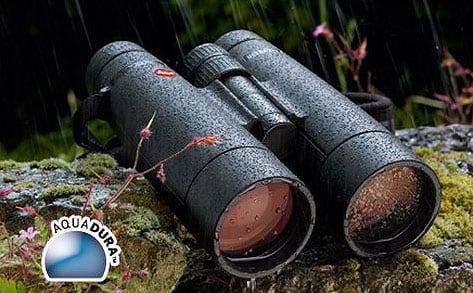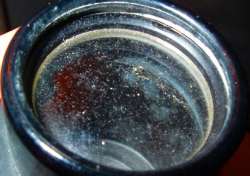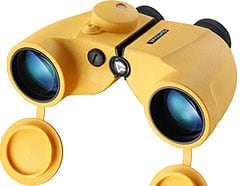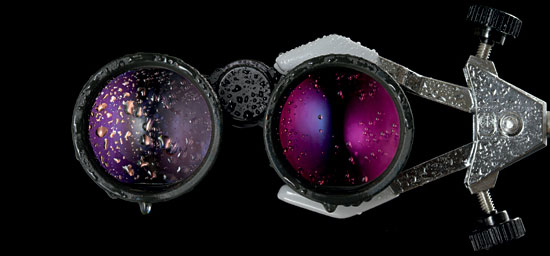All About Fogproof and Waterproof Binoculars

Fogproof & Waterproof Binoculars
These days many binoculars are advertised as being either waterproof, fogproof or both and then there are some that are described as being weather protected or weatherproof, are these all the same and if not what is the difference?
In this guide I will explain what water and fog proofing means, how they make them, do you really need it and list my reviews of some the best fog and waterproof binoculars available.
Waterproofing
Fully waterproof binoculars and spotting scopes are completely sealed internally. This is almost always achieved by using one of the most ingenious, yet simple seals ever developed, the O-ring, which ensures that there is an air and watertight barrier between the lenses, focusing mechanism and the chassis of the binocular.
These seals will prevent any moisture as well as any dust and other small debris from getting inside the unit.
Do you need waterproof binoculars?
If you only use your instrument when the sun is shining, it is only natural to ask “do I need waterproof binoculars?”. My answer to this would still be yes you do and here are the reasons why:
1) Having a waterproof (fully sealed) binocular does not only prevent water from entering the interior, but it will also act as a barrier against dust and other small particles that can end up ruining your view. This is especially important in dry, dusty environments, but also helps if you store them out over long periods, where dust could potentially be a problem.
2) Even though you never take your binoculars out in the rain or even mist, there is still moisture in the air. Whilst this will most probably not immediately affect your optics if you subject your instrument to rapid temperature changes (like taking them out of your warm house into the garden in winter), this can cause any moisture inside your optics to condense or mist up on the inside lens surfaces. Note: As you will read below, most fully waterproof binoculars have the internal air replaced with a dry gas for extra fog protection.

3) If you ever find an old pair of optics (camera, telescope or binocular) in an antique store, you will quite often find a green fungus has grown and attached itself to the inner surface of the lenses. The dry moistureless internal environment of a fully sealed binocular inhibits the growth of molds or fungus and prevents this.
Weatherproof vs Waterproof
This is something that I get asked quite frequently and the confusion is mostly because the term “waterproof” is used a bit too loosely and because there are different degrees of waterproofing.
To be “water-proof” it implies water cannot enter, however, this statement is not qualified and something that is water-proof at normal atmospheric pressures at sea level, for example, may not be when the pressure increases (or indeed decreases). So a binocular that is marketed as being fully water-proof should qualify this by explaining just how waterproof they are, such as to a given depth of immersion and or for a specified period of time. However whilst they may have to demonstrate this to a standards board, it is not always displayed within their marketing material.
But even they don’t quantify it, we can assume that a waterproof device can be fully immersed under a little water for a short period of time, which should cover most reasonable uses for a standard bin.
If a binocular is described as being weather-proof, weather protected or water-resistant they are almost certainly not fully waterproof to any depth even for a short period of time. They do however have some resistance to water and thus should survive light rain, but are not intended to be fully, or even partially immersed in water. Please note that because these water-resistant products are not fully sealed, they are also not fog proof in any way.
If you think that you will need to use your binoculars in a wet environment, make sure that they are 100% waterproof and better still look for ones that advertise just how waterproof they are. Also look out for any standards, for example, the JIS Waterproof Scale, which will describe just how much water your device can take.
Fogproofing
When exposing an unprotected optical device to rapid temperature extremes, especially where there are high levels of humidity, the lenses can fog or mist up, which can at best be a temporary annoyance or at worst permanently ruin the view through them.
To protect against this the air inside the optical barrels is replaced with an inert gas that has no moisture content and thus does not condense. The gas that is used is almost always either nitrogen or argon.
The good news is that today, even fairly inexpensive binoculars and scopes are both waterproof and fogproof.
When reading about binoculars and scopes, you will often come across the term “nitrogen-purging”, which describes the actual process as O2 (oxygen) is removed or purged from the inside of the barrel(s) and replaced with nitrogen.
Obviously to keep the gas inside the chassis, they have to be fully sealed and that is why a fogproof binocular will almost always also be waterproof. But a pair of binoculars can be waterproof without being fogproof. This merely means that the instrument is sealed, but the oxygen inside the barrels haven’t been purged and replaced with an inert gas.
Another point to note is that fogproof binoculars are protected against the fogging up of the internal lens surfaces and not the exterior ones. The advice if the outside surface of your lenses do fog up when taken from a cold to a warm and humid environment is to just allow them to slowly adjust back to the warmer conditions. Do not wipe the condensation off with any old cloth as this may damage your lens or it’s coatings and the condensation will probably reappear anyway.
Nitrogen vs Argon
I have read a number of debates on the web regarding the respective merits of Nitrogen versus Argon gas for fog proofing and it is actually quite hard to separate the hard facts from the marketing hype.
On the one side, I have read some reports that state that because the Argon molecule is larger than the Nitrogen one and can sustain its attributes over a broader temperature range, it is thus said to be more resistant to diffusion or leaking out of the device and so prolongs the life of this air-free environment.
Whilst on the other side, I have read that Nitrogen, Argon, or indeed any other nonreactive gas works as good, not better and the really important bit is that it is a dry gas. Remember that the air in our atmosphere is actually mostly nitrogen (78%) anyway.
Alternatives
I have now also seen a few manufacturers including Leupold that fill the binocular with a blend of Argon and Krypton gas. They maintain that the this improves the fog-proofing even more by virtually eradicating the effects of thermal shock and like the plain Argon gas, this blend has larger molecules than nitrogen which as we have already discussed reduces the diffusion of gases inside your device.
Hermetically Sealed
I have sometimes seen optical devices described as being hermetically sealed. This is just a fancy way of saying that the seal is for practical purposes, considered completely airtight.
Additional Benefits
An additional bonus to having either Argon or Nitrogen gas inside the binocular rather than air is that it stops any mold and fungus growth on the glass surfaces which used to be a problem on older binoculars before the days of sealing.
Fog & Waterproof Binocular Reviews
To get you started, below are a just a few binoculars that I have fully reviewed and recommended, below them are links to all the water & fog proofed bins I have tested in a selection of categories.
Best Waterproof Compact Binoculars
 Pentax DCF LV 9x28 Binoculars
Pentax DCF LV 9x28 Binoculars
These 9x Pentax binoculars achieved an impressive overall score of 70% including an 8/10 for the quality of their optical components is no mean feat for these relatively inexpensive compact binoculars.
Nitrogen purged, they are fully fog and waterproof down to a level of one meter and have an advertised JIS-Class 6 waterproof rating.
- View all reviewed compact waterproof binoculars
Best Mid-Sized Waterproof Binoculars
 Swarovski CL Companion 8x30 Binoculars
Swarovski CL Companion 8x30 Binoculars
Submersion tested to a depth of 4 meters (13ft), the waterproof CL Companion binoculars use dry nitrogen gas to ensure the inner lens surfaces remain fog free.
Not much larger than most compacts, these mid-sized binoculars optically out perform many far larger, yet are one of the most affordable and best value Swarovski binoculars available.
- View all reviewed mid-size waterproof binoculars
Best Value Full-Sized Waterproof Binoculars
 Vanguard Endeavor ED 10x42 Binoculars
Vanguard Endeavor ED 10x42 Binoculars
O-ring sealed and Nitrogen-charged, these Vanguard binoculars also come with features that include an ergonomic, open-bridge design, a wide view angle, phase corrected BaK4 roof prisms, ED glass and fully multi-coated optics.
What is most impressive is however is their price which made them the obvious choice as the best value for money binocular in 2012.
- View all reviewed full-size waterproof binoculars
Applications
General Use:
I cant think of a scenario where water and fog proofing is undesirable, it also just makes sense to have your binocular fully sealed and protected against fogging.
In the past some people may have advised that to save money you could consider an unprotected device if it was not needed. But these days most good quality binoculars are at the very least water resistant and so choosing anything less probably means that the quality of the whole binocular would be very poor and I would not advise getting them for far more reasons than just their weatherproofing.
So my advice, even if you don’t go out in the rain and don’t expose your binocular to rapid temperature changes, still look for water and fogproofing as this is just another sign of quality… and you just never know when it may actually come in handy.
 Marine Binoculars:
Marine Binoculars:
If your optics are for any marine use or will be used near or on a water environment, having fully waterproof binoculars is a no-brainer, because no matter how careful you are, mistakes are bound to happen eventually.
If you plan on using your binoculars on a boat take a look at my guide to choosing marine binoculars that are purposely designed for life on the water.
For example the Vanguard Mariner Binoculars (pictured on the right) will not only handle wet weather, survive submersion to a depth of 5 meters, but also come with a floating strap that ensures they don’t get to that depth. They also have optics optimized for stability on rough waters and some models even come with a built-in compass and rangefinder.
High Humidity & Rainy Environments
Water and fogproof binoculars are also highly recommended in places with high humidity levels like rainforests, or even if near a lot of water like a wetland.
Some of the best birding occurs during inclement weather and one of the main reasons birdwatchers go with binoculars that have both of these features.
Whilst not essential, waterproofing is also a good idea for hunting or if you are taking your binoculars on safari or most other wildlife viewing adventures. Some of my best wildlife experiences have occurred in wet weather and I have often taken guests out on a walking safari in light rain or even in heavy rain on an open-sided game drive vehicle.
Dry and Sandy Environments
It is not only watery and humid conditions where being fully sealed can help: in extremely dry and dusty areas, an airtight seal will prevent dust or other tiny debris from entering the unit.

Water Repellent Lens Coatings
Another feature to look out for if you know you will be using your optics in wet weather are special lens coatings that are actually water repellent and the water droplets just roll off the lens.
The image above is used to highlight the benefits of such a coating known as the AquaDura Coating used on some Leica binoculars. As you can see the treated lens will provide you with a far superior view than the untreated one.
However as well as water, these hydrophobic coatings also often have dirt and oil-repelling properties, which provide a number of benefits beyond making your view better in wet conditions:
- This means your lenses stay cleaner for longer – requiring less frequent cleaning
- They also have improved resistance to scratching
- Also when you do need to clean them, they make it much easier to remove fingerprints, oily markings and dirt particles from the lenses. Thus they require less exuberant cleaning, reducing the chances of permanently scratching the coatings or lens when cleaning and therefore increases the life of your optics.
Found mostly on higher spec bins, a number of manufacturers use their own trademarked name to describe their water repellent coatings:
Standards
JIS Waterproof Scale
The JIS (Japanese Industrial Standards) uses a 0 to 8 scale to rate how watertight a device is and is probably the one that gets used the most, for a very wide range of products:
- JIS Class 0: The device is not protected
- JIS Class 1: Device has protection against vertically falling water drops
- JIS Class 2: Protection against vertically falling water drops when enclosure is tilted up to 15%
- JIS Class 3: Protected against spraying water – Water sprayed at any angle up to 60º on either side of the vertical shall have no harmful effects
- JIS Class 4: Fully protected against splashing water
- JIS Class 5: Protected against water jets – Water projected in jets from any direction against the enclosure shall have no harmful effects.
- JIS Class 6: Watertight – Having no entry of water into inside by receiving direct jet of water from any direction.
- JIS Class 7: The device remains dry after temporary immersion in water
- JIS Class 8: The device remains dry during continuous immersion in water
It is important to remember that this standard is used for many types of products and not just binoculars. Most high end binoculars are JIS 6, JIS 7 or JIS 8 but some low end optics can claim water-proof and only be JIS 1.

 Article | Posted by Best Binocular Reviews
Article | Posted by Best Binocular Reviews 
 Categories:
Categories:  Tags:
Tags: 
